Low-density planting method for rain-fed haloxylon ammodendron sand-fixation forest
A low-density, sand-fixing forest technology, which is applied in botany equipment and methods, plant protection, plant protection covers, etc., can solve the problems of low utilization rate of Haloxylon rainfall, high cost of sand fixation, and difficulty in rainfall infiltration, etc., to achieve increased rainfall Utilization efficiency, saving sand fixation costs, and increasing the effect of rainfall infiltration
- Summary
- Abstract
- Description
- Claims
- Application Information
AI Technical Summary
Problems solved by technology
Method used
Image
Examples
Embodiment Construction
[0023] In order to make the technical means, creative features, objectives and effects of the present invention easy to understand, the present invention will be further explained below in conjunction with specific embodiments.
[0024] A low-density planting method of rain-fed Haloxylon ammodendron sand-fixing forest includes the following steps:
[0025] 1) Haloxylon afforestation:
[0026] ①. Seedling selection: the afforestation time is from late March to early April, and the one-year-old sturdy Haloxylon ammodendron seedlings shall be selected with the seedling height above 20 cm, the main root length above 30 cm, and the root width above 30 cm;
[0027] ② Digging a hole: Choose a relatively flat moving sand 4, judge the main wind direction according to the sand ripple, and draw a line along the direction perpendicular to the main wind direction as the starting line of the Haloxylon forest belt, and dig on the drawn line Two pits, with a width of 40cm, a depth of 40cm, and a pit ...
PUM
 Login to View More
Login to View More Abstract
Description
Claims
Application Information
 Login to View More
Login to View More - R&D
- Intellectual Property
- Life Sciences
- Materials
- Tech Scout
- Unparalleled Data Quality
- Higher Quality Content
- 60% Fewer Hallucinations
Browse by: Latest US Patents, China's latest patents, Technical Efficacy Thesaurus, Application Domain, Technology Topic, Popular Technical Reports.
© 2025 PatSnap. All rights reserved.Legal|Privacy policy|Modern Slavery Act Transparency Statement|Sitemap|About US| Contact US: help@patsnap.com



